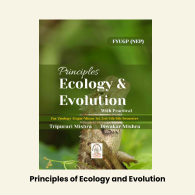

PORIBESH BIGYAN
Inhouse product
-
Rs308.00
Rs350.00 -
Rs288.00
Rs300.00 -
Rs238.00
Rs280.00 -
Rs476.00
Rs595.00 -
Rs374.00
Rs425.00 -
Rs175.50
Rs195.00
Reviews & Ratings
Environmental Science (VAC)” by Dr. Dilip Kalita is designed as a Value-Added Course for the 2nd semester Arts, Commerce, and Science streams under the FYUGP NEP syllabus of Dibrugarh University. This book offers a comprehensive introduction to the principles of environmental science, focusing on ecological balance, biodiversity conservation, pollution control, and sustainable development.
It encourages environmental awareness among students while highlighting the urgent need for environmental protection through both theoretical insights and practical approaches. The content aligns with national education objectives and equips students with the knowledge necessary to make responsible environmental decisions.
Published by Mahaveer Publications, this book is ideal for fulfilling the compulsory environmental studies requirement in undergraduate programmes across universities following the NEP.
UNIT I: ENVIRONMENTAL SCIENCE (8 Lectures, 1 Tutorial) - 15 Marks
1.1 Nature, Scope and Importance of Environmental Science
DEFINITION OF ENVIRONMENTAL SCIENCE
Environmental Science is an interdisciplinary field that integrates physical, biological, and social sciences to study the environment and solve environmental problems. It encompasses the systematic study of our environment and our proper place in it.
NATURE OF ENVIRONMENTAL SCIENCE
Interdisciplinary Approach:
- Physical Sciences: Physics, Chemistry, Earth Sciences
- Biological Sciences: Biology, Ecology, Botany, Zoology
- Social Sciences: Geography, Political Science, Economics, Sociology
- Applied Sciences: Engineering, Agriculture, Medicine, Public Health
Multidisciplinary Character:
- Draws knowledge from multiple fields
- Integrates natural and social sciences
- Combines theoretical and practical approaches
- Links local and global perspectives
SCOPE OF ENVIRONMENTAL SCIENCE
1. Natural Environment Study:
- Atmosphere, hydrosphere, lithosphere, biosphere
- Ecological systems and biodiversity
- Natural resource management
- Climate and weather patterns
2. Human-Environment Interactions:
- Population dynamics and environmental impact
- Urban and rural environmental issues
- Industrial activities and environmental consequences
- Agricultural practices and sustainability
3. Environmental Problems Analysis:
- Pollution types and sources
- Resource depletion and conservation
- Environmental degradation patterns
- Global environmental challenges
4. Solutions and Management:
- Environmental policy and legislation
- Sustainable development strategies
- Environmental restoration techniques
- Green technologies and innovations
IMPORTANCE OF ENVIRONMENTAL SCIENCE
Academic Importance:
- Foundation for understanding Earth systems
- Basis for environmental research and innovation
- Integration of diverse scientific disciplines
- Development of critical thinking about environmental issues
Practical Importance:
- Public Health: Understanding pollution effects on human health
- Resource Management: Sustainable use of natural resources
- Policy Making: Scientific basis for environmental regulations
- Conservation: Protection of biodiversity and ecosystems
- Climate Action: Understanding and addressing climate change
Professional Applications:
- Environmental consulting and assessment
- Conservation and wildlife management
- Environmental education and awareness
- Green technology development
- Environmental law and policy
1.2 Climate Change, Causes, Societal Impacts, Adaptation
UNDERSTANDING CLIMATE CHANGE
Definition: Climate change refers to long-term shifts in global temperatures and weather patterns. While climate variations are natural, scientific evidence shows that human activities have been the main driver of climate change since the 1800s.
CAUSES OF CLIMATE CHANGE
1. Natural Causes:
Solar Variations:
- Changes in solar radiation intensity
- Sunspot cycles affecting Earth's temperature
- Solar flares and coronal mass ejections
- Long-term solar luminosity changes
Volcanic Activity:
- Volcanic eruptions releasing ash and gases
- Sulfur dioxide creating atmospheric cooling
- Large eruptions affecting global climate patterns
- Historical examples: Mount Tambora (1815), Mount Pinatubo (1991)
Ocean Currents:
- Changes in thermohaline circulation
- El Niño and La Niña phenomena
- Gulf Stream variations
- Deep ocean circulation patterns
2. Anthropogenic (Human) Causes:
Greenhouse Gas Emissions:
- Carbon Dioxide (CO2): Fossil fuel burning, deforestation
- Methane (CH4): Agriculture, livestock, landfills
- Nitrous Oxide (N2O): Agriculture, industrial activities
- Fluorinated Gases: Industrial processes, refrigeration
Land Use Changes:
- Deforestation and forest degradation
- Urbanization and infrastructure development
- Agricultural expansion
- Wetland destruction
Industrial Activities:
- Manufacturing processes
- Energy production from fossil fuels
- Transportation systems
- Chemical industry emissions
SOCIETAL IMPACTS OF CLIMATE CHANGE
1. Environmental Impacts:
Temperature Changes:
- Global average temperature rise
- Extreme heat events and heatwaves
- Changes in precipitation patterns
- Melting glaciers and ice sheets
Sea Level Rise:
- Thermal expansion of seawater
- Melting of polar ice caps
- Coastal erosion and flooding
- Saltwater intrusion into freshwater
Ecosystem Disruption:
- Species migration and extinction
- Coral bleaching and marine ecosystem damage
- Forest fires and drought
- Agricultural productivity changes
2. Human Health Impacts:
Direct Health Effects:
- Heat-related illnesses and deaths
- Respiratory problems from air pollution
- Waterborne diseases from contaminated water
- Mental health impacts from disasters
Indirect Health Effects:
- Food insecurity and malnutrition
- Vector-borne disease expansion
- Displacement and migration stress
- Healthcare system strain
3. Economic Impacts:
Agricultural Sector:
- Crop yield variations and failures
- Livestock productivity changes
- Fisheries disruption
- Food price volatility
Infrastructure Damage:
- Extreme weather damage to buildings
- Transportation system disruption
- Energy infrastructure vulnerability
- Coastal infrastructure threats
Economic Costs:
- Climate adaptation and mitigation costs
- Insurance and disaster relief expenses
- Loss of tourism revenue
- Reduced labor productivity
4. Social Impacts:
Population Displacement:
- Climate refugees and migration
- Loss of traditional livelihoods
- Cultural disruption and loss
- Conflict over scarce resources
Inequality Amplification:
- Disproportionate impacts on vulnerable populations
- Gender-specific climate vulnerabilities
- Indigenous community displacement
- Urban-rural disparity in impacts
ADAPTATION STRATEGIES
1. Ecosystem-Based Adaptation:
Natural Infrastructure:
- Mangrove restoration for coastal protection
- Wetland conservation for flood control
- Forest conservation for carbon sequestration
- Green corridors for species migration
Agricultural Adaptation:
- Drought-resistant crop varieties
- Improved irrigation systems
- Crop diversification strategies
- Soil conservation techniques
2. Technological Adaptation:
Infrastructure Resilience:
- Climate-resilient building designs
- Flood barriers and sea walls
- Early warning systems
- Smart grid energy systems
Water Management:
- Rainwater harvesting systems
- Desalination technologies
- Water recycling and reuse
- Efficient irrigation technologies
3. Social and Economic Adaptation:
Community-Based Adaptation:
- Local knowledge integration
- Community disaster preparedness
- Livelihood diversification
- Social safety nets
Policy and Governance:
- Climate adaptation planning
- Disaster risk reduction strategies
- Insurance and financial instruments
- International cooperation mechanisms
1.3 Sustainable Development and Living
CONCEPT OF SUSTAINABLE DEVELOPMENT
Definition: Sustainable development is development that meets the needs of the present without compromising the ability of future generations to meet their own needs. This concept was popularized by the Brundtland Commission in 1987.
PILLARS OF SUSTAINABLE DEVELOPMENT
1. Environmental Sustainability:
- Conservation of natural resources
- Protection of biodiversity and ecosystems
- Pollution prevention and control
- Climate change mitigation and adaptation
2. Economic Sustainability:
- Efficient resource utilization
- Innovation and green technologies
- Sustainable economic growth
- Equitable distribution of benefits
3. Social Sustainability:
- Social equity and justice
- Human rights and dignity
- Cultural preservation
- Community participation and empowerment
PRINCIPLES OF SUSTAINABLE DEVELOPMENT
1. Intergenerational Equity:
- Consideration of future generations
- Long-term thinking in decision making
- Preservation of resources for posterity
- Sustainable resource extraction rates
2. Intragenerational Equity:
- Fair distribution of resources among current populations
- Reducing poverty and inequality
- Access to basic needs for all
- Social justice and human rights
3. Precautionary Principle:
- Prevention of environmental damage
- Scientific uncertainty as reason for caution
- Burden of proof on potential polluters
- Risk assessment and management
4. Polluter Pays Principle:
- Environmental costs internalized by polluters
- Economic incentives for pollution reduction
- Liability for environmental damage
- Market-based environmental policies
SUSTAINABLE LIVING PRACTICES
1. Energy Conservation:
Household Level:
- Energy-efficient appliances and lighting
- Proper insulation and weatherization
- Smart thermostats and energy management
- Renewable energy adoption (solar panels)
Transportation:
- Public transportation usage
- Walking and cycling promotion
- Electric and hybrid vehicles
- Carpooling and ride-sharing
2. Water Conservation:
Domestic Water Use:
- Low-flow fixtures and appliances
- Rainwater harvesting systems
- Greywater recycling
- Native and drought-resistant landscaping
Agricultural Water Use:
- Drip irrigation systems
- Crop selection for local conditions
- Soil moisture monitoring
- Water-efficient farming techniques
3. Waste Reduction and Management:
Reduce, Reuse, Recycle:
- Minimizing consumption and waste generation
- Reusing items and materials creatively
- Proper recycling and composting
- Circular economy principles
Sustainable Consumption:
- Buying local and seasonal products
- Choosing durable and repairable goods
- Supporting sustainable businesses
- Minimalist lifestyle adoption
4. Sustainable Food Systems:
Sustainable Agriculture:
- Organic farming practices
- Permaculture and agroecology
- Local food production and consumption
- Biodiversity conservation in agriculture
Sustainable Diet:
- Plant-based diet adoption
- Reducing food waste
- Supporting local farmers
- Seasonal and organic food choices
UNIT II: ENVIRONMENTAL DEGRADATION (8 Lectures, 1 Tutorial) - 15 Marks
2.1 Land Degradation: Causes and Consequences
DEFINITION OF LAND DEGRADATION
Land degradation is the reduction or loss of biological or economic productivity and complexity of terrestrial ecosystems, including soils, vegetation, other biota, and the ecological and hydrological processes that operate within the system.
TYPES OF LAND DEGRADATION
1. Soil Erosion:
- Water Erosion: Sheet, rill, and gully erosion
- Wind Erosion: Deflation and abrasion processes
- Gravity Erosion: Mass wasting and landslides
- Coastal Erosion: Wave action and sea-level rise
2. Soil Chemical Degradation:
- Salinization: Salt accumulation in soils
- Acidification: pH reduction and acid formation
- Pollution: Chemical contamination from industrial sources
- Nutrient Depletion: Loss of essential soil nutrients
3. Soil Physical Degradation:
- Compaction: Soil structure destruction
- Crusting: Surface hardening and impermeability
- Waterlogging: Excessive water accumulation
- Subsidence: Land surface lowering
CAUSES OF LAND DEGRADATION
1. Natural Causes:
Climate Factors:
- Extreme weather events (droughts, floods)
- Temperature variations and freeze-thaw cycles
- Wind patterns and intensity
- Rainfall amount and distribution
Geological Factors:
- Natural soil formation processes
- Tectonic activities and earthquakes
- Volcanic eruptions and ash deposits
- Natural slope instability
2. Human-Induced Causes:
Agricultural Practices:
- Overgrazing: Excessive livestock grazing
- Monoculture: Single crop cultivation
- Intensive Farming: Heavy machinery use and chemical inputs
- Poor Irrigation: Waterlogging and salinization
Deforestation and Land Use Change:
- Forest clearing for agriculture
- Urban expansion and infrastructure development
- Mining and quarrying activities
- Construction and industrial development
Industrial Activities:
- Chemical pollution and contamination
- Heavy metal deposition
- Industrial waste disposal
- Air pollution and acid rain
CONSEQUENCES OF LAND DEGRADATION
1. Environmental Consequences:
Ecosystem Disruption:
- Loss of biodiversity and habitat destruction
- Disruption of food chains and ecological balance
- Reduced ecosystem services
- Increased vulnerability to natural disasters
Hydrological Impacts:
- Reduced water infiltration and groundwater recharge
- Increased surface runoff and flooding
- Sedimentation of water bodies
- Water quality deterioration
Climate Effects:
- Reduced carbon sequestration capacity
- Increased greenhouse gas emissions
- Changes in local climate patterns
- Dust storms and air quality problems
2. Socio-Economic Consequences:
Agricultural Productivity:
- Reduced crop yields and quality
- Increased production costs
- Food insecurity and malnutrition
- Loss of arable land
Economic Impacts:
- Reduced land values
- Increased costs for land rehabilitation
- Loss of tourism revenue
- Healthcare costs from health impacts
Social Impacts:
- Rural-urban migration and displacement
- Loss of traditional livelihoods
- Increased poverty and inequality
- Social conflicts over land resources
2.2 Exploitation of Surface and Ground Water
WATER RESOURCES OVERVIEW
Global Water Distribution:
- Oceans: 97.5% of total water
- Freshwater: 2.5% of total water
- Accessible Freshwater: Less than 1% of total water
- Surface Water: Rivers, lakes, streams
- Groundwater: Aquifers and underground sources
SURFACE WATER EXPLOITATION
1. Types of Surface Water Sources:
Rivers and Streams:
- Perennial and seasonal rivers
- Urban and rural water supply
- Industrial and agricultural use
- Hydroelectric power generation
Lakes and Reservoirs:
- Natural lakes and artificial reservoirs
- Water storage and flood control
- Recreation and fisheries
- Drinking water supply
2. Methods of Surface Water Exploitation:
Direct Extraction:
- Pumping stations and intake structures
- Canal systems and aqueducts
- Gravity-fed distribution systems
- Temporary and permanent diversions
Storage and Management:
- Dam construction and reservoir creation
- Water treatment and purification
- Distribution network development
- Water conservation measures
3. Impacts of Surface Water Exploitation:
Environmental Impacts:
- Altered flow regimes and ecosystem disruption
- Habitat fragmentation and species displacement
- Water quality deterioration
- Downstream flow reduction
Social Impacts:
- Displacement of communities for dam construction
- Conflicts over water rights and access
- Loss of traditional fishing and agriculture
- Cultural and heritage site submersion
GROUNDWATER EXPLOITATION
1. Groundwater Systems:
Aquifer Types:
- Confined Aquifers: Pressurized underground water
- Unconfined Aquifers: Water table aquifers
- Perched Aquifers: Small, isolated water bodies
- Artesian Wells: Naturally pressurized systems
Recharge and Discharge:
- Natural recharge from precipitation
- Artificial recharge through injection
- Natural discharge through springs
- Human extraction through wells
2. Methods of Groundwater Exploitation:
Well Construction:
- Shallow wells and tube wells
- Deep boring and drilling
- Hand pumps and motorized pumps
- Artesian well development
Extraction Technologies:
- Submersible pumps and systems
- Solar-powered pumping
- Wind-powered extraction
- Gravity-fed systems
3. Impacts of Groundwater Over-Exploitation:
Physical Impacts:
- Water Table Decline: Lowering of groundwater levels
- Land Subsidence: Ground surface sinking
- Saltwater Intrusion: Seawater contamination in coastal areas
- Well Interference: Competition between wells
Environmental Impacts:
- Depletion of aquifer systems
- Reduction in spring flows
- Wetland drying and ecosystem loss
- Baseflow reduction in rivers
Economic Impacts:
- Increased pumping costs
- Well deepening and replacement costs
- Agricultural productivity decline
- Infrastructure damage from subsidence
2.3 Air Pollution: Anthropogenic Causes, Impact on Health, Agriculture, Climate, Hydrology
AIR POLLUTION OVERVIEW
Definition: Air pollution is the presence of harmful substances in the atmosphere that pose risks to human health, environmental quality, and climate stability.
ANTHROPOGENIC CAUSES OF AIR POLLUTION
1. Industrial Sources:
Manufacturing Industries:
- Chemical Industries: Release of volatile organic compounds (VOCs)
- Steel and Iron Production: Particulate matter and sulfur compounds
- Cement Manufacturing: Dust and carbon dioxide emissions
- Textile Industries: Chemical vapors and dyes
Power Generation:
- Coal-Fired Power Plants: Sulfur dioxide, nitrogen oxides, particulates
- Oil-Fired Plants: Carbon monoxide and hydrocarbons
- Nuclear Plants: Radioactive emissions (minimal under normal operation)
- Biomass Burning: Particulates and organic compounds
2. Transportation Sources:
Road Transportation:
- Gasoline Engines: Carbon monoxide, nitrogen oxides, hydrocarbons
- Diesel Engines: Particulate matter, nitrogen oxides
- Heavy Vehicles: Black carbon and particulates
- Traffic Congestion: Increased emissions per kilometer
Aviation and Shipping:
- Aircraft emissions at high altitudes
- Ship emissions in ports and coastal areas
- Fuel quality and emission standards
- International transportation regulations
3. Agricultural Sources:
Livestock Agriculture:
- Methane emissions from ruminants
- Ammonia from animal waste
- Dust from animal operations
- Odor and volatile organic compounds
Crop Agriculture:
- Pesticide and fertilizer application
- Burning of crop residues
- Dust from field operations
- Methane from rice paddies
4. Residential and Commercial Sources:
Household Activities:
- Cooking: Biomass burning, gas combustion
- Heating: Wood, coal, and oil burning
- Waste Burning: Open burning of household waste
- Consumer Products: Aerosols and volatile chemicals
Commercial Activities:
- Dry cleaning solvents
- Paint and coating applications
- Restaurant emissions
- Office building emissions
MAJOR AIR POLLUTANTS
1. Primary Pollutants:
- Carbon Monoxide (CO): Incomplete combustion
- Sulfur Dioxide (SO2): Fossil fuel burning
- Nitrogen Oxides (NOx): High-temperature combustion
- Particulate Matter (PM): Direct emission from sources
- Volatile Organic Compounds (VOCs): Industrial and transport sources
2. Secondary Pollutants:
- Ozone (O3): Photochemical reactions
- Sulfuric Acid (H2SO4): SO2 oxidation
- Nitric Acid (HNO3): NOx reactions
- Secondary Particulates: Chemical formation in atmosphere
HEALTH IMPACTS OF AIR POLLUTION
1. Respiratory System Effects:
Acute Effects:
- Coughing, wheezing, and throat irritation
- Shortness of breath and chest pain
- Asthma attacks and bronchitis
- Eye, nose, and throat irritation
Chronic Effects:
- Chronic Obstructive Pulmonary Disease (COPD)
- Lung Cancer: Particularly from particulates and carcinogens
- Reduced Lung Function: Long-term exposure effects
- Increased Respiratory Infections
2. Cardiovascular System Effects:
- Heart attacks and strokes
- High blood pressure and arrhythmias
- Atherosclerosis and blood vessel damage
- Increased risk of heart disease
3. Other Health Effects:
- Neurological Effects: Cognitive decline and dementia
- Reproductive Effects: Birth defects and pregnancy complications
- Cancer: Various types linked to air pollution
- Premature Death: Reduced life expectancy
4. Vulnerable Populations:
- Children and elderly individuals
- People with pre-existing health conditions
- Pregnant women and developing fetuses
- Outdoor workers and urban residents
AGRICULTURAL IMPACTS
1. Crop Damage:
Direct Effects:
- Leaf Damage: Visible injury and necrosis
- Growth Reduction: Stunted development and reduced yields
- Quality Deterioration: Reduced nutritional value
- Premature Aging: Early senescence and death
Specific Pollutant Effects:
- Ozone: Cellular damage and reduced photosynthesis
- Sulfur Dioxide: Leaf burn and chlorophyll destruction
- Nitrogen Oxides: Growth stimulation followed by damage
- Particulates: Reduced light penetration and stomatal clogging
2. Soil and Water Impacts:
- Acid Rain: Soil acidification and nutrient leaching
- Heavy Metal Deposition: Soil contamination
- Water Quality: Surface and groundwater pollution
- Microbial Activity: Disruption of soil organisms
3. Economic Impacts:
- Reduced agricultural productivity and income
- Increased costs for pollution mitigation
- Market value reduction of damaged crops
- Food security implications
CLIMATE IMPACTS
1. Greenhouse Gas Effects:
Global Warming Potential:
- Carbon Dioxide: Primary greenhouse gas
- Methane: 25 times more potent than CO2
- Nitrous Oxide: 298 times more potent than CO2
- Fluorinated Gases: Thousands of times more potent
Climate Feedback Mechanisms:
- Ice-albedo feedback
- Water vapor feedback
- Cloud formation changes
- Ecosystem carbon release
2. Regional Climate Effects:
- Urban Heat Islands: Elevated temperatures in cities
- Precipitation Changes: Altered rainfall patterns
- Extreme Weather: Increased frequency and intensity
- Air Quality-Climate Interactions: Complex feedback systems
HYDROLOGICAL IMPACTS
1. Acid Rain Effects:
- Surface Water Acidification: pH reduction in lakes and streams
- Groundwater Contamination: Soil leaching of toxic metals
- Aquatic Ecosystem Damage: Fish kills and biodiversity loss
- Infrastructure Corrosion: Buildings and monuments
2. Water Quality Impacts:
- Chemical Contamination: Direct pollutant deposition
- Nutrient Loading: Nitrogen and phosphorus deposition
- Toxic Substances: Heavy metals and organic compounds
- Drinking Water Safety: Treatment challenges and costs
3. Hydrological Cycle Changes:
- Evaporation Rates: Temperature and humidity effects
- Precipitation Patterns: Regional and seasonal changes
- Runoff Characteristics: Urban and rural watershed impacts
- Water Resource Availability: Quantity and quality changes
UNIT III: ENVIRONMENTAL CASE STUDIES AND COMMUNITY BASED ACTIVITIES (10 Lectures) - 20 Marks
3.1 Wildlife, Poaching, Man-Wildlife Conflicts, Conservation and Mitigation
WILDLIFE CONSERVATION OVERVIEW
Importance of Wildlife:
- Biodiversity maintenance and ecosystem stability
- Economic value through tourism and recreation
- Cultural and spiritual significance
- Scientific research and medical discoveries
- Ecosystem services and environmental balance
WILDLIFE POACHING
1. Definition and Scope: Poaching is the illegal hunting, capturing, or killing of wildlife in violation of local, national, or international laws. It represents one of the most serious threats to global biodiversity.
2. Types of Poaching:
Commercial Poaching:
- Trophy Hunting: Illegal hunting for animal parts (tusks, horns, skins)
- Traditional Medicine: Animals killed for perceived medicinal properties
- Exotic Pet Trade: Capture of rare species for private collections
- Bush Meat Trade: Subsistence and commercial meat hunting
Subsistence Poaching:
- Local communities hunting for food
- Cultural and traditional practices
- Poverty-driven wildlife exploitation
- Lack of alternative livelihood options
3. Target Species and Products:
High-Value Targets:
- Elephants: Ivory tusks for ornaments and traditional medicine
- Rhinoceros: Horns for traditional medicine and status symbols
- Tigers: Bones, skin, and organs for traditional medicine
- Pangolins: Scales for traditional medicine, meat for consumption
Other Affected Species:
- Marine species (sharks for fins, sea turtles for shells)
- Birds (parrots for pet trade, birds of prey for falconry)
- Primates (bushmeat and pet trade)
- Reptiles (snakes for skin, crocodiles for leather)
4. Drivers of Poaching:
Economic Factors:
- High black market prices for wildlife products
- Poverty and lack of economic opportunities
- International demand and trade networks
- Corruption and weak law enforcement
Social and Cultural Factors:
- Traditional beliefs and practices
- Status symbols and luxury consumption
- Cultural ceremonies and rituals
- Lack of conservation awareness
5. Impacts of Poaching:
Ecological Impacts:
- Population decline and species extinction
- Ecosystem disruption and imbalance
- Loss of keystone species
- Genetic diversity reduction
Economic Impacts:
- Loss of tourism revenue
- Reduced ecosystem services
- Cost of law enforcement and protection
- International trade restrictions
MAN-WILDLIFE CONFLICTS
1. Definition and Nature: Human-wildlife conflict occurs when the needs and behavior of wildlife impact negatively on humans, or when humans negatively affect the needs of wildlife.
2. Types of Conflicts:
Crop Raiding:
- Elephants: Destroying crops and storage facilities
- Wild Boar: Damaging agricultural fields
- Monkeys and Apes: Raiding fruit crops and gardens
- Birds: Eating seeds and grains
Livestock Predation:
- Large Carnivores: Lions, tigers, leopards, wolves
- Small Carnivores: Foxes, jackals, wild dogs
- Aerial Predators: Eagles and other raptors
- Aquatic Predators: Crocodiles and large fish
Human Safety Threats:
- Direct attacks by large mammals
- Disease transmission from wildlife
- Venomous snake bites
- Property damage and infrastructure destruction
3. Causes of Human-Wildlife Conflicts:
Habitat Loss and Fragmentation:
- Conversion of natural habitats for agriculture
- Urban expansion and infrastructure development
- Forest degradation and deforestation
- Climate change affecting habitat suitability
Resource Competition:
- Competition for water sources
- Grazing land conflicts with livestock
- Food source depletion in natural habitats
- Territorial overlap between humans and wildlife
Human Population Growth:
- Increased human settlements in wildlife areas
- Expansion of agricultural activities
- Infrastructure development in wildlife corridors
- Increased human presence in natural areas
4. Impacts of Human-Wildlife Conflicts:
Human Impacts:
- Economic losses from crop and livestock damage
- Human injuries and fatalities
- Psychological stress and fear
- Reduced quality of life in affected communities
Wildlife Impacts:
- Retaliatory killing of wildlife
- Habitat degradation and loss
- Population decline and local extinctions
- Behavioral changes and stress
CONSERVATION STRATEGIES
1. Protected Area Management:
National Parks and Reserves:
- Strict protection of core habitats
- Scientific management and monitoring
- Tourism development for economic benefits
- Research and education programs
Buffer Zones:
- Graduated protection around core areas
- Limited human activities and sustainable use
- Community participation in management
- Corridor establishment for wildlife movement
2. Community-Based Conservation:
Community Participation:
- Local communities as conservation partners
- Traditional knowledge integration
- Benefit-sharing mechanisms
- Capacity building and training programs
Conservation Incentives:
- Compensation for wildlife damage
- Employment in conservation activities
- Eco-tourism revenue sharing
- Alternative livelihood programs
3. Species-Specific Conservation:
Captive Breeding Programs:
- Ex-situ conservation for endangered species
- Genetic diversity maintenance
- Reintroduction programs
- Research and education facilities
Translocation and Reintroduction:
- Moving animals to safer habitats
- Establishing new populations
- Genetic rescue programs
- Ecosystem restoration
MITIGATION MEASURES
1. Conflict Prevention:
Physical Barriers:
- Electric Fencing: Crop protection from elephants
- Traditional Fencing: Various materials and designs
- Trenches and Ditches: Barrier creation
- Guard Structures: Watchtowers and shelters
Deterrent Methods:
- Sound Deterrents: Firecrackers, noise makers, alarm systems
- Light Deterrents: Flashing lights and reflectors
- Chemical Deterrents: Repellent sprays and odors
- Biological Deterrents: Guard animals and companion planting
2. Early Warning Systems:
- Wildlife movement monitoring
- Community alert networks
- Technology-based detection systems
- Rapid response teams
3. Compensation and Insurance:
- Government compensation schemes
- Community insurance programs
- Rapid assessment and payment procedures
- Fair and transparent processes
4. Livelihood Alternatives:
- Eco-tourism development
- Non-timber forest product harvesting
- Sustainable agriculture practices
- Skill development and training programs
CASE STUDIES
1. Project Tiger (India):
- Establishment of tiger reserves
- Relocation of villages from core areas
- Anti-poaching measures and monitoring
- Community participation and compensation
2. African Elephant Conservation:
- CITES trade restrictions on ivory
- Community conservancies in Kenya and Namibia
- Human-elephant conflict mitigation
- International cooperation and funding
3. Snow Leopard Conservation:
- Transboundary conservation efforts
- Community-based livestock insurance
- Alternative energy programs
- International Snow Leopard Trust initiatives
PRACTICAL APPLICATIONS AND WASTE MANAGEMENT
3.2 Waste Management: Solid Waste, Urban Waste, Industrial Waste and Pollution
Frequently Bought Products
English Language & Communication Skills
jog (yoga)
Product Queries (0)
Login Or Registerto submit your questions to seller
Other Questions
No none asked to seller yet
-
Rs308.00
Rs350.00 -
Rs288.00
Rs300.00 -
Rs238.00
Rs280.00 -
Rs476.00
Rs595.00 -
Rs374.00
Rs425.00 -
Rs175.50
Rs195.00
Mahaveer Publications
Mahaveer Publications is a trusted name in the world of printing and publishing, renowned for delivering high-quality printed materials tailored to meet the needs of individuals, businesses, and organizations. Specializing in books, brochures, magazines, and custom printing solutions, Mahaveer Publications combines state-of-the-art technology with a commitment to excellence. With a focus on precision, creativity, and timely delivery, the company has earned the trust of clients seeking professional and impactful print solutions.
Dedicated to fostering knowledge and communication, Mahaveer Publications is more than just a printing service—it's a partner in bringing ideas to life. From concept to completion, the team ensures that every project reflects the client's vision while maintaining the highest standards of craftsmanship. With a passion for innovation and a customer-centric approach, Mahaveer Publications continues to set benchmarks in the printing and publishing industry.









